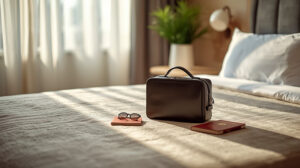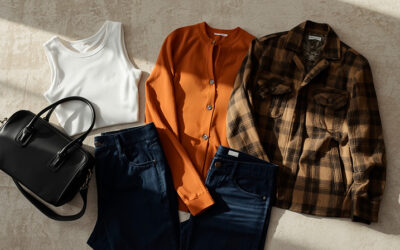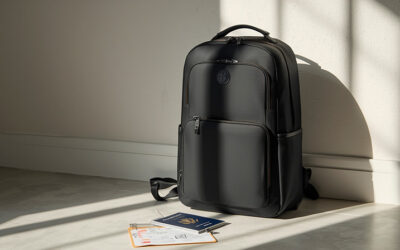10 Smart Packing Tips for Minimalist Travelers
There’s a certain irony in how we approach travel. We dream of freedom, spontaneity, and adventure—yet we drag along suitcases so heavy they could anchor a small boat. We pack for every possible scenario, from impromptu black-tie events to sudden snowstorms in the tropics and end up wearing the same three outfits on repeat while the rest sits untouched, adding weight to our backs and anxiety to our journey.
I learned this the hard way during my first back packing trip through Southeast Asia. I arrived at a small guesthouse in Chiang Mai, lugging a 70-liter backpack up three flights of narrow stairs in 95-degree heat. Sweating and exhausted, I unzipped my bag only to realize I’d packed four pairs of jeans (in Thailand!), two hair dryers, and enough toiletries to supply a small pharmacy. Meanwhile, the seasoned travelers around me breezed by with sleek daypacks and carefree smiles.
That moment changed everything. Minimalist travel isn’t just a buzzword or Instagram aesthetic—it’s a philosophy that transforms how you move through the world. It’s about choosing freedom over «just in case.» It’s about being agile, adaptable, and unburdened by the weight of unnecessary things.
Today, I’m sharing 10 smart packing tips for minimalist travelers that will revolutionize your travel prep—whether you’re planning a weekend city break, a month-long backpacking odyssey, or a streamlined business trip. These aren’t just packing hacks; they’re principles that will make every journey lighter, simpler, and infinitely more enjoyable.
1. Start with the Right Bag
Your bag isn’t just a container—it’s the foundation of your entire packing strategy. Choose a quality carry-on suitcase or a 40-45 liter travel backpack, and here’s the key: make sure it has limits.
The psychological truth of packing is simple: space expands to accommodate whatever you’re willing to bring. Give yourself a cavernous 80-liter backpack, and you’ll find ways to fill every pocket and compression strap. Restrict yourself to a carry-on, and suddenly you become ruthlessly efficient, questioning every item’s true necessity.
Look for bags with smart organization—multiple compartments, compression straps, and easy access points. A clamshell-opening backpack, for instance, lets you pack like a suitcase while maintaining the mobility of a backpack. The best bag is one that fits airline carry-on restrictions (typically 22″ x 14″ x 9″), saves you baggage fees, and keeps everything you need within arm’s reach.
2. Follow the One-Bag Rule
This is the golden principle of minimalist travel: if it doesn’t fit in one bag, it doesn’t come with you. Period.
The one-bag rule forces you to confront the difference between wanting something and needing it. That extra pair of dress shoes? The bulky travel pillow? The five «just in case» sweaters? When space is limited, these items reveal themselves as the comfort blankets they truly are—nice to have, but ultimately unnecessary.
I’ve traveled for weeks with nothing but a 40-liter backpack, moving through varying climates and situations, and never once felt deprived. In fact, I felt liberated. There’s no waiting at baggage claim, no anxiety about lost luggage, no exhausting shuttle between hotel and taxi with unwieldy bags. You simply grab your pack and go.
The one-bag rule also has an unexpected benefit: it makes you a more present traveler. Without the burden of managing multiple pieces of luggage, you’re free to take spontaneous detours, hop on last-minute transportation, and navigate crowded markets or steep staircases without breaking a sweat.
3. Build a Capsule Wardrobe
Here’s where minimalist packing becomes an art form. A travel capsule wardrobe is a small, intentional collection of clothing where every piece works with every other piece. Think of it as a modular wardrobe system designed for maximum versatility with minimum items.
Start with a neutral color palette—blacks, grays, navies, and earth tones—that allows for effortless mixing and matching. Choose fabrics that are lightweight, quick-drying, and wrinkle-resistant. Merino wool is the holy grail: it regulates temperature, resists odors, and can be worn multiple days between washes.
Here’s a sample one-week capsule for a temperate climate:
- 3 tops (2 t-shirts, 1 long-sleeve)
- 2 bottoms (1 pair of pants, 1 pair of shorts or a skirt)
- 1 versatile jacket or cardigan
- 4-5 pairs of underwear
- 3-4 pairs of socks
- 1 outfit for dressier occasions (optional)
With three tops and two bottoms, you can create six different outfit combinations. Add a jacket or accessories, and the possibilities multiply. The key is choosing pieces that serve multiple purposes—a button-down shirt that works for both hiking and dinner, pants that transition from day to evening, a scarf that doubles as a blanket on cold flights.
4. Roll, Don’t Fold
This tip seems simple, but it’s transformative. Rolling your clothes instead of folding them accomplishes three things: it saves space through compression, reduces wrinkles by eliminating sharp creases, and makes items immediately visible when you open your bag.
The technique is straight forward: lay the garment flat, smooth out wrinkles, and roll tightly from one end to the other. For t-shirts, fold the sleeves inward first. For pants, fold them in half lengthwise before rolling. Stack your rolls vertically in your bag like file folders—this «filing» method lets you see everything at once without disturbing other items.
Pro tip: roll your heaviest items first and place them at the bottom of your bag (or closest to your back if using a backpack). This keeps the weight distributed properly and prevents your bag from becoming top-heavy and uncomfortable.
5. Use Packing Cubes
If rolling is transformative, packing cubes are revolutionary. These zippered fabric containers are the organizational tool that converts chaotic bag-digging into smooth, systematic packing.
Assign each cube a category: one for tops, one for bottoms, one for underwear and socks, one for tech accessories. Compression packing cubes take this even further, squeezing out excess air to reduce volume by up to 60%. The beauty is that you can pull out a single cube, find what you need, and return it without disrupting your entire bag’s ecosystem.
Packing cubes also work wonders for keeping clean and dirty clothes separated during your trip. Use one color for clean items and another for worn clothes, or designate a specific cube as your «laundry bag.» When you arrive at your accommodation, you can simply pull out the cubes you need without unpacking everything—perfect for short stays or frequent moves.
6. Swap Liquids for Solids
Liquid toiletries are the enemy of minimalist packing. They’re heavy, they leak, they’re subject to TSA’s 3-1-1 rule, and they take up precious space. The solution? Go solid.
Solid shampoo bars, conditioner bars, soap bars, and toothpaste tablets are compact, TSA-friendly, and last significantly longer than their liquid counterparts. A single shampoo bar can replace two or three bottles, and since they’re not liquid, you can pack them anywhere without worry.
The environmental benefits are substantial too—no plastic bottles, less water weight during shipping, and often more natural ingredients. Solid deodorant, sunscreen sticks, and moisturizer bars round out the solid toiletry kit.
Keep your solid toiletries dry between uses with a proper carrying case that has drainage or ventilation. This prevents them from becoming mushy and extends their lifespan considerably.
💡 For a smarter way to carry your soap and toothbrush, discover the CleanTrip Gear Kit here.
7. Limit Shoes to Two Pairs
Shoes are the space-eaters of travel. They’re bulky, heavy, and often the first thing we overpack. Here’s the minimalist rule: bring one pair to wear and one backup pair in your bag—maximum.
Choose your shoes strategically based on your trip. For most travel, you’ll want:
1. Your workhorse shoes: Comfortable walking shoes or sneakers that you’ll wear 80% of the time
2. Your specialized pair: Sandals for beach destinations, dress shoes for business trips, or hiking boots for outdoor adventures
Wear your bulkiest pair during transit to save bag space. If you’re traveling somewhere with varied activities, opt for versatile shoes that can handle multiple situations—like trail runners that work for both hiking and casual city walking, or leather sneakers that transition from day to evening.
Pack shoes strategically: stuff them with socks or small items to maximize space, place them in shoe bags to protect clothing, and position them at the bottom of your bag or in outside pockets.
8. Go Digital Where Possible
In the age of smartphones and tablets, physical items like books, maps, travel guides, and printed tickets are largely unnecessary weight. Embrace the digital shift and reclaim that space.
Download books, magazines, and guidebooks to your phone or e-reader. Use apps like Google Maps for offline navigation (download maps before you travel). Store travel documents, tickets, and reservations in cloud storage or specialized travel apps. Take photos of important documents as backup.
This extends to entertainment too. Instead of packing a journal, notebook, pens, and travel games, a single tablet with the right apps can provide reading material, navigation, entertainment, journaling, and communication—all in one slim device.
Don’t forget to pack the right charging accessories: a universal adapter, a portable battery bank, and the appropriate cables. Consider a multi-port USB charger to reduce the number of charging blocks you need
9. Adopt the «Wear it Twice» Rule
One of the biggest mindset shifts in minimalist travel is letting go of the expectation that you need a fresh outfit every day. The truth? No one on your trip knows or cares that you wore the same shirt yesterday.
Choose technical fabrics designed to be worn multiple times between washes. Merino wool, as mentioned earlier, naturally resists odors and can be worn for days without washing. Quick-dry synthetics can be washed in a sink and dry overnight, ready for another wear.
Master the sink laundry technique: use a small amount of travel detergent or even hand soap, agitate gently, rinse thoroughly, and roll items in a towel to squeeze out excess water. Hang to dry overnight (a portable travel clothesline with clips is invaluable here).
By washing items every few days, you can get by with far fewer clothes. This isn’t about being dirty or unkempt—it’s about being strategic and reducing unnecessary bulk.
10. Leave Space for the Journey
Here’s the paradox of minimalist packing: by bringing less, you create room for more. Not more stuff necessarily, but more experiences, discoveries, and spontaneity.
Leave about 20% of your bag empty when you depart. This breathing room serves multiple purposes. It accommodates souvenirs and treasures you’ll find along the way—local textiles, regional specialties, or meaningful gifts. It provides space for items you might need to purchase during your trip. It allows your bag to accommodate unexpected weather changes or situations.
More importantly, that empty space represents flexibility and possibility. It’s a physical reminder that you don’t need to plan for every contingency, that you can adapt as you go, and that sometimes the best part of travel is figuring things out as you go.
Minimalist travel isn’t about deprivation—it’s about prioritization. It’s about recognizing that the less you carry, the more freely you move. It’s about understanding that the memories you create weigh nothing at all, while the stuff you bring weighs you down.
Packing light isn’t a sacrifice; it’s a gift you give yourself. With these 10 smart packing tips, you’re not just saving space in your luggage—you’re creating space in your journey for spontaneity, ease, and genuine freedom.
Every seasoned traveler eventually arrives at the same conclusion: the less you bring, the richer the experience. You move faster, adapt quicker, and worry less. You become more resourceful, more present, and more open to whatever the road offers.
The next time you prepare for a trip, resist the urge to pack for every hypothetical situation. Instead, pack for the journey you want to have—light, agile, and unburdened. Trust that you have everything you need, and that anything you lack can be figured out along the way.
After all, the best travel stories rarely involve the things we packed. They involve the people we met, the places we discovered, and the versions of ourselves we became when we let go of excess and embraced the essential.
Less weight, more adventures. That’s the minimalist traveler’s promise—and it’s one that will transform every journey you take.
💡 For a smarter way to carry your soap and toothbrush, discover the CleanTrip Gear Kit here.








0 comentarios